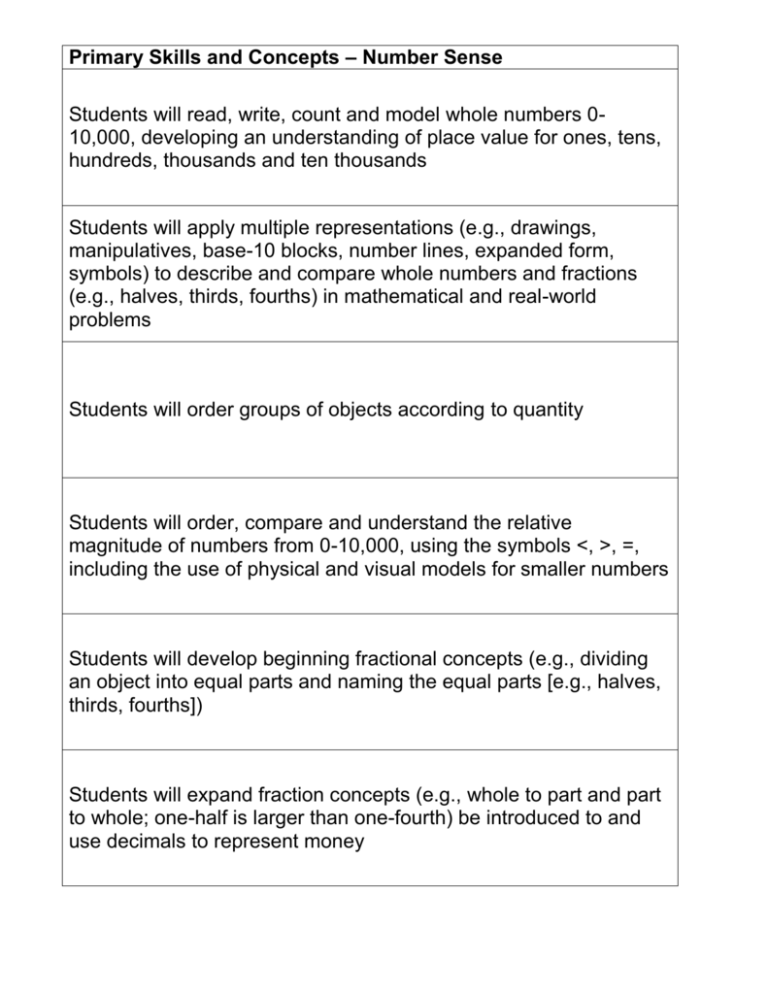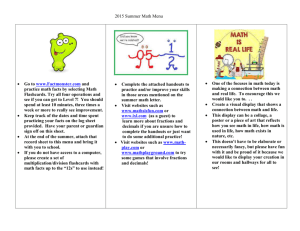number_sense_POS_bigger
advertisement

Primary Skills and Concepts – Number Sense Students will read, write, count and model whole numbers 010,000, developing an understanding of place value for ones, tens, hundreds, thousands and ten thousands Students will apply multiple representations (e.g., drawings, manipulatives, base-10 blocks, number lines, expanded form, symbols) to describe and compare whole numbers and fractions (e.g., halves, thirds, fourths) in mathematical and real-world problems Students will order groups of objects according to quantity Students will order, compare and understand the relative magnitude of numbers from 0-10,000, using the symbols <, >, =, including the use of physical and visual models for smaller numbers Students will develop beginning fractional concepts (e.g., dividing an object into equal parts and naming the equal parts [e.g., halves, thirds, fourths]) Students will expand fraction concepts (e.g., whole to part and part to whole; one-half is larger than one-fourth) be introduced to and use decimals to represent money Grade 4 Skills and Concepts – Number Sense Students will apply multiple representations (e.g., drawings, manipulatives, base-10 blocks, number lines, expanded form, symbols) to represent whole numbers (0 to 1,000,000) Students will read, write and model whole numbers from 0 to 1,000,000, developing place value for hundred thousands and millions Students will order and compare numbers to 1,000,000 and understand their relative magnitude Students will investigate and apply multiple representations of commonly used and equivalent fractions through twelfths (e.g., 1/2=3/6) and decimals through thousandths with manipulatives (e.g., drawings, manipulatives, base-10 blocks, number lines, expanded form, symbols) Students will explore the use of simple ratios to describe problem situations Students will explore the relationship between fractions, decimals and percents Students will apply whole numbers, commonly used fractions and decimals to represent real-world problems Students will explain how the base 10 number system relates to place value Students will develop equivalent relationships between commonly used fractions, decimals and whole numbers (e.g., 1/2=0.5, 4/2=2, 2=2.0) Students will graph a whole number, commonly used fraction or decimal on a number line Grade 5 Skills and Concepts – Number Sense Students will read, write, model, order, compare (using relative magnitude) and apply multiple representations of whole numbers Students will compare and apply the relative sizes of common and mixed fractions Students will investigate multiple representations of equivalent fractions (e.g., 21 36 , 112 32 ) with manipulatives, drawings and fractional notation Students will explore the use of simple ratios to describe problem situations Students will explore, investigate, compare, relate and apply relationships among whole numbers, fractions, decimals and percents Students will read, write, identify and compare decimals through ten-thousandths Grade 6 Skills and Concepts – Number Sense Students will continue to develop number sense using fractions, decimals and percents, including percents greater than 100% and improper fractions Students will extend applications of operations ( ,,, ) to include fractions and decimals Students will develop place value of large and small numbers, including decimals Students will explore positive integral exponents (e.g. squares, cubes) Students will compare, order and convert between whole numbers, fractions, decimals and percents using concrete materials, drawings or pictures and mathematical symbols (e.g., ,,,,, , order on a number line) Grade 7 Skills and Concepts – Number Sense Students will extend number sense for percents and integers Students will extend applications of operations ( ,,, ) to include integers Students will develop number sense for π (pi) as one example of an irrational number Students will use whole number exponents to represent/express numbers Students will compare, order and determine equivalent relationships among fractions, decimals and percents Students will provide examples of and use models, diagrams and symbols (e.g., number lines, 10 by 10 grids, rectangular arrays, number sentences) to describe and write equivalent forms of integers, fractions, decimals, percents, square roots and π Grade 8 Skills and Concepts – Number Sense Students will continue to develop number sense to include irrational numbers (e.g., square roots, cube roots, π) Students will provide examples of, describe and compare irrational and rational numbers (e.g., magnitude, order on a number line, scientific notation, very large and very small integers, numbers close to zero) Students will describe and provide multiple representations of numbers (rational, square roots, cube roots and π) in a variety of equivalent forms using models, diagrams and symbols based on real-world and/or mathematical situations High School Skills and Concepts – Number Sense Students will compare real numbers using order relations Students will locate the position of a real number on the number line, find its distance from the origin (absolute value/magnitude) and find the distance between two numbers on the number line (the absolute value of their difference) Students will determine the relative position on the number line of real numbers, including very large and very small numbers, and the relative magnitude of numbers expressed in fractional form, in decimal form, as roots or in scientific notation Students will explore vectors and matrices as systems that have some of the properties of the real number system Students will compare and contrast number systems, including complex numbers as solutions to quadratic equations that do not have real solutions







